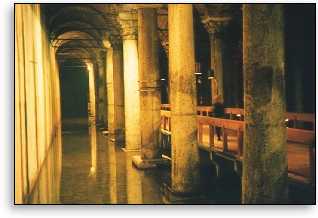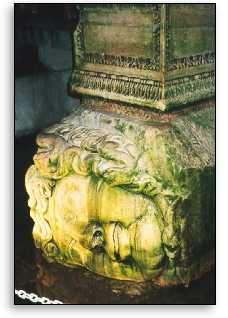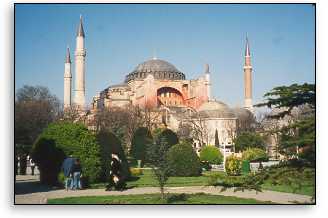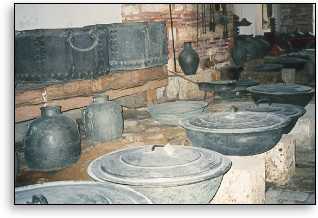Bascilica Cistern, Turkish and
Islamic Art Museum,
Aya Sofia, Topkapi Palace
Western Turkey - Group Journal
Day 2 -
Sunday, 5 April 1998, Istanbul
by Ed & Kate Kennell
A midnight power outage prevented the daily 5:30 a.m. loudspeaker prayers, so we were allowed to awaken peacefully by an alarm clock - what a treat!
We breakfasted at the hotel and left at 8:45. All were in attendance except Christine the Mysterious whom we'd not yet met, but were assured was resting in sick bay to join us later. Becky & Jim took off in Taxi splendor due to her ankle's outcome when she'd nearly disappeared into an unmarked sidewalk stairwell the evening before. We administered last rites to a couple dozen sheep gathered in a lot nearby. They did not seem overly pleased to be the stars of the upcoming festival, Kurban Bayrami. (Meli mentioned that we'd be fortunate to be out of the city for their bloodbath on Tuesday.)

At 9:00 we picked our dive buddies and descended into the dank depths of the Basilica Cistern. Although strategic in location - being not only the east/west, but also the north/south control point, this peninsula was, nevertheless, bone dry. From earliest times, aqueducts were essential for settlements to survive, much less thrive here. This particular storage cavern, built by Justinian in the 6th century, drew water 19 kilometers from the Belgrade Forest. Using the Turkish general measuring system, the cistern measured "40 x 72" meters and contained "1001" meters of water! In early times, excess water was removed by buckets when it was filled to capacity, threatening holding power.

Byzantine columns supporting the roof were a classic example of functional recycling; columns, bases and Medusa's faces all ended up in the strangest places! Thus we began our theme of synthesis in Turkey.
After Julie explained the toilet kitty - incubator connection*, and we had our first group potty stop, we moved on into the Turkish & Islamic Art Museum at 10:00. Just when we were beginning to get overwhelmed by Anatolian history, tea was served, to stimulate our burdened concentration. Anatolia translates into "nourishing mother" and our already increasing waistlines are testament to this phrase!
As tea progressed, we learned more of the history of Istanbul which, basically translates into 100 years of "dodging bullets" and donning fine duds, only to finally be overrun from the East by Turkey's namesake. In 1453, the Turks changed the city's name from Constantinople to "To the City of" or, Istanbul.
We moved on through the museum to view fine examples of Islamic and Turkish arts; calligraphy, stone, metalwork, woodwork, tiles and carpets; all representative of iconoclastic restraints (i.e., no people depicted).
The lower level contained several life-sized dioramas which chronicled the decline of women's influence as they moved from sole matriarchal power into a life of decorative luxury in the earlier years of this century. Of great interest were the depictions of home life - from a nomadic yurt to settled city lifestyles.
Next to a helicopter crash that we'd seen yesterday near the spice market, the items we found most intriguing were the 13th century astrolabe and an 18th century device which allowed the traveling Muslim to accurately locate Mecca.
Lunch was a hurried affair at The Pudding Shoppe; a former hippie dive now gone legit (made famous in "Midnight Express." It was here that we first tasted ayran, a slightly salty yogurt drink, which - apparently, is supposed to be especially effective for warding off the effects of summer's heat. Maybe it just isn't hot enough yet, but I don't think it was an instant hit with the majority of our group.

Off to the Aya Sophia Museum cum walk-in cooler at 1:40. Completed by Justinian as a church in 537 A.D., the top dome collapsed just 37 years later. Rebuilt and slightly elongated, it remained the largest enclosed space for 1000 years. After the Turk's invasion, its stunning mosaics were plastered over, only to be revealed again after Ataturk declared it a museum, rather than a mosque.
We exited through a 2,000 year old gate, brought by the architect from his home town, Miletus, to grace his finest work.
By 2:30 we were headed to what Meli called the "concrete tent" but known to others as Topkapi Palace, the fortified abode of sultans from 1462 until they moved across the Golden Horn last century. More than a home, however, it is a collection of gardens, houses, libraries and a 400 room harem.

We first explored the cavernous kitchen areas where food was prepared daily for thousands of people. There we viewed gargantuan cookware, silver and priceless porcelains. Next we moved along the palace grounds to view the dazzling display of gold and items in the treasury. Items such as emerald bricks, a diamond-studded garter, the movie-made-famous dagger, amber pipe bits and an 87 carat diamond.
As 4:00 passed, we departed through the Gate of Heaven and independently made our way back to the Otel Sofya. Some stopped to shop (or haggle, at least), some dropped off for desserts, and others of us made our way back to the roof top terrace to relax with a glass of champagne, (courtesy of Bud and Nancy) and enjoy the fine view.
At 7:00 we had a group meet in the lobby, at which we were introduced to Raquella & Mahmut, Meli's guides-in-training, and discussed safety, security, health and other issues.
Having been reminded about the value of group punctuality, we met again, (punctually!) at 8:45 and schooled toward the fish market for dinner at the Dogen restaurant, where we consumed a mackerel and mussel entrée to the accompaniment of a "musical" gypsy group - and whereupon we discovered that an empty plastic 1-liter water bottle held to the ear (sea-shell style) makes a most effective sub-woofer. Perhaps this very type of music is why Rick Steves provided those earplugs.
A walk back to the hotel after dinner ended our first very full day of Turkey Through the Back Door with Meli.
* Ed note: We each contributed 1,000,000 lira ($4.00) to the kitty for potty stops. The public toilets always have a guard posted near the entrance collecting about 25-50,000 lira for the privilege of using them. Any money left over in the kitty at the end of the tour is given to a one-room clinic in Guzelyurt, for example to buy incubators for premature babies.